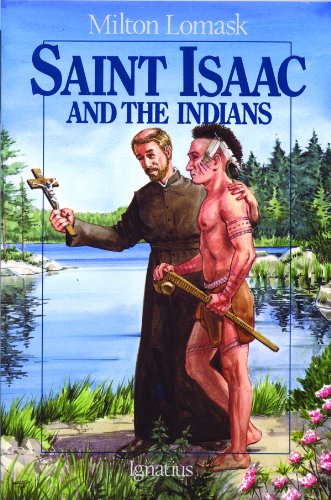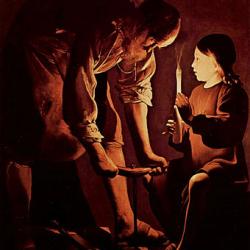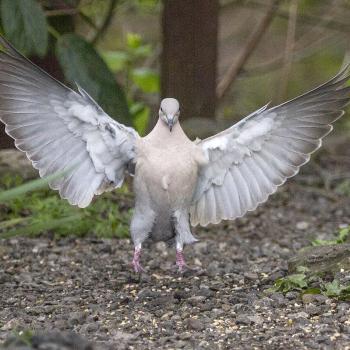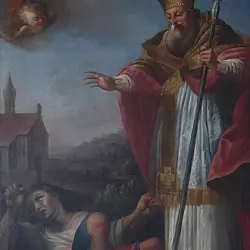- Happy Mother Cabrini Day Everybody.
There used to be a time when people thought the earth was the center of the universe and that the
sun revolved around it. Thanks to a Catholic scientist named Nicolaus Copernicus we discovered the opposite was true. There was a time when Europe used to think of itself as the center of the universe. Despite what many people think of this man, thanks to Christopher Columbus we discovered that that is not true. When we say Columbus discovered America, what we really mean is that he discovered it for Europe which thought itself the cultural epicenter of life. People had been living in North and South America for centuries before civilized Europe ever set foot on its shores.

When Jesus commissioned his apostles to spread the gospel to the whole world, he also meant the un-Christianized lands that they had no idea existed. Eventually his church descended upon its land hoping to spread and evangelize its people. Here are some of these who have lived and died as Americans.
Just to note that this blog post is not meant to give an in-depth scholarly analysis of American Catholic saints. It’s not meant to be a detailed Pulitzer award winning article. These musings are meant to give you a bite sized brief overview and glance at some of the very fine saintly Catholic men and women who have lived in America since the 17th century. Most of the individuals mentioned are canonized Saints, Blesseds, Venerables, Servants of God and Americans.
I love to explore the world these people lived in and love to mention the neat, fascinating and cool people, places, events and things that were happening around them.
I could have mention more significant things and not have mentioned less significant things.
There are more great Catholics then these people and perhaps I will blog about them at a later date.
So on this day when we celebrate Christopher Columbus, here are some American Catholic Saints worth knowing about.
Let’s being our journey into American Catholic history with the earliest saints to walk Ameicra …
St. Isaac Jogues, S.J. (10 January 1607 – 18 October 1646) and companions.
Canonized 29 June 1930, Vatican City by Pope Pius XI
Feast October 19 (General Roman Calendar) September 26 (Canada)
In 1636 before St. Issac went to New France to live amongst the Native people some other priests who had returned from the area, described the incredible hardships, terrible treacheries and awful tortures that awaited missionaries that dared ventured there, to which his reply was. ‘Sign me Up and Bring It On!!! His desire to bring Christ to those that might actually make his life more than a little unpleasant was fuel for his soul as he fully desired to save theirs.
He returned from his first missionary journey a little worse for the ware. Before he had only been warned about how bad life was amongst living with the Native Americans. Now he had almost been killed. Surely he could now retire with a clear conscience. But NOPE. He had to keep spreading Christ.
For if I preach the gospel, I have nothing to boast of, for I am under compulsion; for woe is me if I do not preach the gospel.
1 Corinthians 9:16
This eventually leads to his death. But Fr. Isaac was actually martyred twice. The man who killed him with a tomahawk was eventually captured and sentenced to death. While awaiting death he had a conversation and was baptized. His new name- Father Isaac Jogues. For the Love of Jesus he was willing and ready to share and participate in his sufferings to bring salvation to the very people who wanted to kill him.
It wasn’t until the 20th century that him and his brother martyrs were recognized as saints.
Further Resources
Saint Among Savages: The Life of St. Isaac Jogues by Francis Talbot (1935)
Saints Of The American Wilderness: The Brave Lives And Holy Deaths Of The Eight North American Martyrs by John A. O’Brien (1953)Saint Isaac and the Indians by Milton Lomask (1991)
Saint Isaac Jogues: With Burning Heart (Encounter the Saints Series,12)by Christine Orfeo, Mary Tebo, et al. (May 1, 2002)
The Jesuit Martyrs of North America by John J. Wynne S.J. | May 5, 2020
Saints Isaac Jogues and John de Brebeuf – On YouTube

Saint Frances Xavier Cabrini or Mother Cabrini (December 22, 1917: Aged 67)
Canonized July 7, 1946, by Pope Pius XII.
Feast November 13th
She was the first U.S. citizen to be canonized as a Saint by the Roman Catholic Church.
She was born 4 years after Bl. Pius IX was elected Pope and 4 years before the dogma of the Immaculate Conception was proclaimed and 200 years after the death of St. Isaac Jogues, S.J.
November 1880– She started the Missionary Sisters of the Sacred Heart of Jesus (M.S.C.)
September 1887-Mother Cabrini went to seek approval from Pope Leo XIII to establish missions in China. But instead of going to China he told her “Not to the East, but to the West”.
March 31, 1889, along with six other sister she went to the United States to help the poor Italian immigrants who were coming to America.
1917- She dies the same year the Blessed Mother appears to the Fatima children.
March 20, 2020 -Jared Polis the Governor of Colorado abolishes Columbus Day as a state holiday and replaces it with a new state holiday in honor of St. Mother Frances Xavier Cabrini.
“Did a Magdalene, a Paul, a Constantine, an Augustine become mountains of ice after their conversion? Quite the contrary. We should never have had these prodigies of conversion and marvelous holiness if they had not changed the flames of human passion into volcanoes of immense love of God.”- St. Mother Cabrini
Further Resources
God’s Messenger: The Astounding Achievements of Mother Cabrini: A Novel Based on the Life of Mother Frances X. Cabrini (2017)
by Nicole Gregory
Immigrant Saint: The Life of Mother Cabrini (2017) by Pietro Di Donato
Mother Cabrini (1959) by
Fr. James Martin on Mother Cabrini On YouTube
St. Elizabeth Anne Seaton (August 28, 1774 – January 4, 1821)
Canonized September 14, 1975, by Pope Paul VI
Feast January 4th
St. Elizabeth Seton is the first American Roman Catholic saint who was born in the US. (Way to go America).
She established the first Catholic girls’ school in the nation in Emmitsburg, Maryland, where she also founded the first American congregation of religious sisters, the Sisters of Charity.
She is also a former Episcopalian.
“I will go peaceably and firmly to the Catholic Church: for if Faith is so important to our salvation, I will seek it where true Faith first began, seek it among those who received it from God Himself.”
She was born a year before Pius VI was elected pope and 2 years before the signing of the Declaration of Independence.
This was the confirmation name of Kristin.
When Baby Kristin was sick when she was born, but her mother prayed for St. Elizabeth Seaton’s intercession and miraculously my wife lived and writes for you today.
Further Resources
Life story of Mother Seton (1924) Mother Seton and the Sisters of Charity (1957)
Saint Elizabeth Ann Seton Daughter Of America (1999)
Elizabeth Seton: American Saint (2018) by Catherine O’Donnell
Kate “Star Trek’s Captain Janeway” Mulgrew stars in Time For Miracles On YouTube
St. Katharine Drexel (November 26, 1858 – March 3, 1955)
Canonized October 1, 2000 by Pope John Paul II
Feast March 3rd
She was the second American to be canonized a saint and the first one born a U.S. citizen. Come on America, were slagging behind the rest of the world. South America has more saints then we do. St. Katharine was born the same year Our Lady of Lourdes appeared to St. Bernadette and only 4 years after the dogma of the Immaculate Conception was proclaimed. She grew up in a rich home, but her parents were not glued to their wealth. They were devout Catholics who had a chapel in their home and they opened up their home to the poor several times a week. Her foundation as a saint was pretty solid.
When Sr. Cabrini meet with the pope she was encouraged to go to America to minister to the Italian immigrants in need of such assistance. When Catherine meet with Bl. Pope Leo XIII, he encouraged her to minister to the native Americans in the Western United States. In 1889s she began her journey into religious life with the goal of serving American Indians and Afro-Americans. This headline from the he Philadelphia Public Ledger says it all.
“Miss Drexel Enters a Catholic Convent—Gives Up Seven Million”
She died 5 years after the dogma of Ascension of Mary was proclaimed. Her birth and death were surrounded by Marian dogmas. Pretty good for a Catholic Saint.
“If we wish to serve God and love our neighbor well, we must manifest our joy in the service we render to Him and them. Let us open wide our hearts. It is joy which invites us. Press forward and fear nothing.”
-St. Katharine Drexel
Further Resources
Saint Katharine Drexel: Friend of the Oppressed (2002) by Ellen Tarry
Saint Katharine Drexel: The Total Gift (Encounter the Saints Series, 15) (20030) by Susan Helen Wallace and Barbara Kiwak
Katharine Drexel: The Riches-to-Rags Life Story of an American Catholic Saint (2014) by Cheryl C. D. Hughes
Saint Katharine: The Life of Katharine Drexel (2014) by Cordelia Frances Biddle
Prince Demetrius Augustine Gallitzin (December 22, 1770 – May 6, 1840)
Prince Demetrius became a Servant of God on June 6, 2005
Fr. Gallitzin was born 6 years before the signing of the declaration of Independence and is a contemporary of St. Seaton.
St. Seaton was a convert from the Episcopal church. Fr. Gallitzin was a convert from the Russian Orthodox Church.
St. Drexel came from a rich family. Fr. Gallitzin came from a rich royal family. She became a nun and he became a priest. One of the first priests ordained in the United States. He was ordained by the first bishop and archbishop in the United States, John Carrol. Bishop Carrol was cousin Charles Carroll of Carrollton (1737–1832) the only Catholic signer of the Declaration of Independence. Fr. Gallitzin is another living example of how God can take anybody from anywhere in any social class and make them His own. He is a man full of charity for others and also very ecumenical for his time.
Whatever differences on points of doctrine may exist amongst the different denominations of Christians, all should be united in the bonds of charity, all should pray for one another, all should be willing to assist one another; and, where we are compelled to disapprove of our neighbor’s doctrine, let our disapprobation fall upon his doctrine only, not upon his person.– St. Prince Demetrius Augustine Gallitzin
One of the more interesting aspects of his life is the time he was involved with a haunted house. That story is told on Jimmy Akan’s Mysterious World listed below.
Further Resources
Demetrius A. Gallitzin Complete Epistolary (Postulazione Servo di Dio Demetrius A. Gallitzin Book 1)(2015)
by Demetrius Gallitzin and Luis Escalante
Jimmy Akin’s Mysterious World Page
American Catholic History on Fr. Gallitzin
Venerable Mary Angeline Teresa, O.Carm. (January 21, 1893 – January 21, 1984),
Mary Angeline Teresa, O.Carm founder of the Carmelite Sisters for the Aged and Infirm (where I work at St. Patrick’s Manor) is declared Venerable on June 28,2012. This order sprang off from the Little Sisters of the Poor and was the first American Community of religious women founded solely to care for the aged in 1929. As of 2019, 90 years later, the Carmelite Sisters serve in 18 elder-care facilities around the country, plus one in Ireland. Venerable Sister Mary reminds one of St. Jeanne Jugan with her dedication to care for the Elderly.
“If you have to fail, let it be on the side of kindness. Be kinder than kindness itself to the old people.”
Further Resources
The servant of God, Mother M. Angeline Teresa, O. Carm. (1893-1984) (1990)
Miriam Teresa Demjanovich (March 26, 1901 – May 8, 1927)
Beatified October 4, 2014, Newark, New Jersey, United States, by Angelo Amato
Feast May 8th
Teresa Demjanovich an American Ruthenian Catholic Sister of Charity is beatified at the first beatification ceremony to take place in the United States. The Ruthenian Greek Catholic Church, also known in the United States as the Byzantine Catholic Church, is an Eastern Catholic church that uses the Byzantine Rite for its liturgies, laws, and cultural identity. It is one of the 23 Eastern Catholic churches that are in full communion with the Holy See. She was a Byzantine Rite Catholic wo served as a Religious Sister in a Roman Rite congregation. She was only a postulant and novice when she made her final vows articulo mortis (danger of death) before she died.
She resembles another Teresa who was also in very ill health and around the same age when she died. Like St. Therese, Sister Teresa’s saintly life, her striving for perfection in her religious life, her spiritual writings, and the favors received by others after her death through her intercession with God, the Sisters of Charity petitioned Rome for permission to open a cause for her beatification. She had even looked into be a Carmelite. She died two years after St. Therese was canonized.
“Union with God, then, is the spiritual height God calls everyone to achieve … The imitation of Christ in the lives of saints is always possible and compatible with every state of life. The saints did but one thing — the will of God. But they did it with all their might.”- Blessed Miriam Teresa Demjanovich
I just want to mention here my FB friend Sister Christina Marie Neumann who serves at St. Anne’s Living Center, a home for the elderly and disabled in North Dakota. She maintains the blog at Our Franciscan Fiat, sharing thoughts, reflections, and stories from daily life as a Franciscan Sister. I plan on interviewing her at some point in the near future. Check out her blog for her community.
At Monday’s Mass, after communion, I sang the beautiful chant “Adoramus Te, Christe,” having committed it to memory during Holy week a couple of years ago. The words that really touched my heart now where: “redemesti mundum,” “[because by your Holy Cross] You have redeemed the world.”
At Mass, I am able to offer this suffering, this feeling of injustice, this frustration, united to the cross of Christ. It is wondrous to realize that “he’s got this!” This crazy situation in the world, and in my life, is already incorporated into His paschal mystery.
No matter how dark things may look, we can remember that he has redeemed the world.
Sister Christina Marie Neumann, Redemisti Mundum (September 15, 2020) Our Franciscan Fiat
Further Resources
blessed miriam teresa demjanovich : prayers blessed miriam teresa demjanovich by catholic prayers
The better part the life of Teresa Demjanovich (1952) by Theodore Maynard
Sister Miriam Teresa Demjanovich (1901-1927) (1979) by Mary Zita Geis SC
St. Junípero Serra (November 24, 1713 – August 28, 1784)
Canonized September 23, 2015, Basilica of the National Shrine of the Immaculate Conception by Pope Francis
Feast July 1st
In recent months, St. Serra has made the news. In the toppling over statue craze of 2020, his statue was vandalized and knocked down because of supposed injustices of the past that he participated in. Was St. Serra a bad hombre? Bishop Barron explains better then anyone about his extraordinary saintly life.
It is no exaggeration to affirm that from the missions established by Junípero Serra came much of the political and cultural life of the state of California. Many of our greatest cities—San Diego, Los Angeles, San Francisco, Santa Barbara, and yes, Ventura—were built on the foundation of the missions. And I won’t hesitate to say it: the spread of the Christian faith in this part of the world took place largely because of the work of Junipero Serra and his colleagues—and this is a good thing! Jesus told his first followers to go into all the world and preach the Good News, not as a message of oppression but of spiritual liberation. It was precisely in response to that apostolic summons that Fray Junípero left Majorca, crossed the ocean, and spent the remainder of his life proclaiming Christ to those who did not know him. Though it is politically incorrect to say it today, this kind of enthusiastic evangelism is to be celebrated, not excoriated. The majority of Catholics in California today have the faith that they cherish because Padre Serra first brought it here.
– Bishop Robert Barron, Canceling Padre Serra,(July 20, 2020) Word on FireWe found on our journey, as well as in the place where we stopped, that they treated us with as much confidence and good-will as if they had known us all their lives.-St. Junípero Serra
Further Resources
Junipero Serra: California’s Founding Father (2013) by Steven W. Hackel
Journey to the Sun: Junipero Serra’s Dream and the Founding of California (2014) by Gregory Orfalea
The Man Who Founded California: The Life of Saint Junipero Serra (2015) by M.N.L. Couve de Murville
Saint Junipero Serra’s Camino: A Pilgrimage Guide to the California Missions (2017) by Stephen J. Binz
Blessed Stanley Rother (March 27, 1935 – July 28, 1981)
Beatified September 23, 2017 Cox Convention Center, Oklahoma City, United States by Cardinal Angelo Amato, S.D.B.
Feast July 28
Father Stanley Francis Rother is the first US-born priest and martyr to be beatified by the Catholic Church and the second person to be beatified on US soil after Blessed Miriam Teresa Demjanovich. He was from Oklahoma and was murdered in Guatemala where he served the native American Tz’utujil people located in Santiago Atitlán in the rural highlands of southwest Guatemala. He learned their language and in true missionary fashion translated the New Testament into Tz’utujil and began the regular celebration of the Mass in Tz’utujil. In the late 1960s Fr. Rother founded in Panabaj a small hospital, dubbed as the “Hospitalito”. Since there was not a Tz’utujil name equivalent to “Stanley,” the people of Rother’s mission affectionately called him “Padre Apla’s,” translated as “Father Francis,” a nod to his middle name.
Now Fr. Rother knew that his catechists and parishioners were being killed by a right wing death squad. He knew that his name was #8 on a list of people to kill. But in-spite of the very real death threats that he received, he never the less stayed with his people whom he had ministered to all those years.
The shepherd cannot run at the first sign of danger … I still don’t want to abandon my flock when wolves are making random attacks.- Blessed Stanley Rother
He joins St. Oscar Romero, Blessed James Alfred Miller ( and some others in being killed in Central America in the early 80’s. A mission church has been named after him in Decatur, Arkansas, in the Roman Catholic Diocese of Little Rock; it is the first Catholic church anywhere in the world to be named after him.
Further Resources
The Shepherd Who Didn’t Run: Blessed Stanley Rother, Martyr from Oklahoma, Revised (2018) by Maria Ruiz Scaperlanda | Sold
Servant of God Black Elk (December 1, 1863 – August 19, 1950)
Black Elk is declared a Servant of God on October 21, 2017
He was a wičháša wakȟáŋ (“medicine man, holy man”) and heyoka of the Oglala Lakota people.
He was a second cousin of the war leader Crazy Horse.
He was present at the Battle of the Little Bighorn in 1876.
He traveled to England with Buffalo Bill’s Wild West where the troupe put on a command performance for Queen Victoria, whom they called “Grandmother England in 1887.
He also participated in the fighting at the Wounded Knee Massacre in 1890.
He married his first wife, Katie War Bonnet, in 1892. She converted to Catholicism, and all three of their children were baptized as Catholics.
He became a Catholic after his wife’s death (1903) in 1904, when he was in his 40s. He was christened with the name of Nicholas and later served as a catechist in the church.
He married again in 1905 to Anna Brings White, a widow with two daughters. Together they had three more children, whom they also had baptized as Catholic. The couple were together until her death in 1941.
For the last thirty years I have lived very differently from what the white man told about me. I am a believer. The Catholic priest Short Father baptized me thirty years ago. From then on they have called me Nick Black Elk. Very many of the Indians know me. Now I have converted and live in the true faith of God the Father, the Son, and the Holy Spirit. Accordingly, I say in my own Sioux Indian language, “Our Father, who art in heaven, hallowed be thy name,” as Christ taught us and instructed us to say. I say the Apostle’s Creed and I believe it all.
BLACK ELK’S LAST TESTAMENTFurther Resources
Nicholas Black Elk: Medicine Man, Missionary, Mystic (2011) by Michael F. Steltenkamp
Black Elk Speaks: The Complete Edition (2014) by John G. Neihardt , Vine Deloria
Black Elk: The Life of an American Visionary (2016) by Joe Jackson
Solanus Casey (November 25, 1870 – July 31, 1957)
Beatified 18 November 18, 2017, Detroit, Michigan by Angelo Amato
Feast July 30th
Fr. Solanus Casey was the third American beatified on American soil. From 1924, a year before St. Therese was canonized, till 1945, the end of World War 2, he was a priest at Saint Bonaventure convent in Detroit. He was an accomplished speaker, started a soup kitchen for the poor, and played Irish songs on the violin for his fellow monks. He was much sought after by people and miracles are known to have taken place during his lifetime. And his big mission at the convent was that he was the doorkeeper. He was the man who greeted you when you went to visit the convent. Just a humble doorkeeper, whom people sought out to visit and talk to. God again loves to highlight certain individuals who by all appearances seem to look like ordinary everyday people, but who are radiant glowing people inside.
“Many are the rainbows, the sunbursts, the gentle breezes—and the hailstorms—we are liable to meet before, by the grace of God, we shall be able to tumble into our graves with the confidence of tired children into their places of peaceful slumber.”
Further Resources
God’s Doorkeepers: Padre Pio, Solanus Casey And Andre Bessette (2011) by Joel Schorn
Father Solanus Casey, Revised and Updated (2017) by Catherine Odell
Thank God Ahead of Time: The Life and Spirituality of Solanus Casey (2017) by Michael Crosby OFM Cap
They Walked with God: St. Bernadette Soubirous, St. John Vianney, St. Damien of Molokai, St. Andre Bessette, Bl. Solanus Casey
(2019) Diane Allen
An Hour With Solanus Casey by (2020) Fr. Byron CSsR Miller
Solanus Casey: The Healing Prophet Prime Video
Solanus Casey: Priest, Porter, Prophet DVD
Sr. Thea Bowman (December 29, 1937 – March 30, 1990)
Sr. Thea Bowman is declared a Servant of God Nov. 14, 2018 .
According to Wikipedia...
She was born Bertha Bowman in Yazoo City, Mississippi, in 1937. Her grandfather had been born a slave but her father was a physician and her mother a teacher. She was raised in a Methodist home but, with her parents’ permission, converted to the Roman Catholic faith at the age of nine and later joined the Franciscan Sisters of Perpetual Adoration at La Crosse, Wisconsin.
Bowman attended Viterbo University, run by her congregation, and earned a B.A. in English in 1965.[2] She went on to attend The Catholic University of America in Washington, D.C., where she earned a M.A. in English in 1969 and a Ph.D. in English in 1972, writing her doctoral thesis on Thomas More.
Bowman became instrumental in the publication in 1987 of a new Catholic hymnal, Lead Me, Guide Me: The African American Catholic Hymnal, the first such work directed to the Black community.
Her 1988 albums, Songs of My People and ‘Round the Glory Manger, released on stereo audiocassette by the Daughters of St. Paul, were re-released in 2020 for the 30th anniversary of Sister Thea’s death under the title, Songs of My People: The Complete Collection
What does it mean to be black and Catholic? It means that I come to my church fully functioning. That doesn’t frighten you, does it? I come to my church fully functioning. I bring myself, my black self, all that I am, all that I have, all that I hope to become, I bring my whole history, my traditions, my experience, my culture, my African American song and dance and gesture and movement and teaching and preaching and healing and responsibility as gift to the Church.
-Servant of God Sr. Thea Bowman
Further Resources
Thea’s Song: The Life of Thea Bowman (2012) by Charlene Smith and John Feister
Thea Bowman In My Own Words (2015) by Maurice Nutt CSsR
An Hour with Thea Bowman (2018) by Maurice Nutt Cssr
Thea Bowman: Faithful and Free (People of God) (2019) by Maurice J. Nutt CSsR
Sister Thea Bowman: Do You Hear Me, Church? (2020) by Peggy A. Sklar
Father Augustus Tolton (April 1, 1854 – July 9, 1897),
Fr. Augustus Tolton is declared a servant of God by Pope Francis. on June 12, 2019.
Former slave Augustus Tolton seemed to have trouble finding a place to fit into his Catholic faith. When his family first escaped slavery they moved to the free state of Illinois in the city of Quincy. Augustus joined St. Boniface Catholic School but had to leave due to harassment from fellow students and their parents threatening to withdraw financial support. He went to another school, St. Peters, in which he was enthusiastically welcomed by the pastor Fr. Peter McGirr, but not by the parishioners. The warm Catholic community threated the good priest with violence and threats to contact his bishop.
When he was hoping to join the Franciscans, he got rejected. When he wanted to join a seminary to become a priest, no American seminary would accept him. But finally….
Augustine was accepted to the Urbanum Collegium de Propaganda Fide in Rome. He departed on February 15, 1880, and arrived March 12, the feast of Pope Gregory the Great, “one of the most determined enemies of slavery who ever sat in the Chair of Peter.”18 Augustine was welcomed unconditionally and sincerely by the Vatican, not only as a seminarian, but also as a full member of the Church. For the first time in his life, Augustine sensed the sublime delight of the brotherhood of man under the fatherhood of God. . . . He experienced the security of equality and justice, a sense of dignity and worth, the comfort and companionship of friends, the joy of mutual charity and benevolence. . . . The oppressive weight of segregation was removed; the race barriers were gone. He never felt lonely, unwanted, or out of place. He was treated as a person . . . as a child of God.
Deacon Harold Burke-Sivers, Father Augustus Tolton: The Slave Who Became the First African-American Priest (2019) . EWTN Publishing, Inc.
Fr. Tolton’s story reminds me that Jesus was rejected also by his own people. His perseverance in the face of overwhelming societal racism gives testimony that although our own Church community may reject us, God never will. I do pray that all those of Catholics that rejected him repented of their sins. May he forgive those today who still practice racism and prejudice against others. May he root it out of me entirely as well.
Further Resources
Father Augustus Tolton: The Slave Who Became the First African-American Priest (2019) by Deacon Harold Burke-Sivers
From Slave to Priest: The Inspirational Story of Father Augustine Tolton (1854-1897) (2010)
by Caroline Hemesath and Deacon Harold Burke-Sivers
An Hour with Augustus Tolton (2019) by Maurice J. CSsR Nutt
Blessed Michael J. McGivney (August 12, 1852 – August 14, 1890)
Beautified October 31, 2020
We end with our latest beatified saint.
My friend Marshall was for a time a grand knight in the Knights of Columbus. My wife was a member of the female equivalent of the Knights, The Daughters of America. I inquired about possibly joining myself. I have been to the Knights museum in Connecticut a few times which is a fascinating walk into history.
The Knights of Columbus was started by Fr. McGivney. Wikipedia has a nice summary of why he started the Knights…
From his own experience, McGivney recognized the devastating effect on immigrant families of the untimely death of the father and wage earner. Many Catholics were still struggling to assimilate into the American economy. On March 29, 1882, while an assistant pastor at Saint Mary’s Church in New Haven, Connecticut, McGivney founded the Knights of Columbus, with a small group of parishioners, as a mutual aid society, to provide financial assistance, in the event of the men’s deaths, to their widows and orphans. The organization developed as a fraternal society. McGivney was also known for his tireless work among his parishioners.
McGivney spent seven years at St. Mary’s, then became pastor of St. Thomas Church in Thomaston in 1884. He died from pneumonia at the age of 38 in Thomaston on the eve of the Assumption in 1890.
The Knights of Columbus was among the first groups to recruit blood donors, with formal efforts dating to 1937 during the Great Depression. As of 2013, the order has more than 1.8 million member families and 15,000 councils. During the 2012 fraternal year, the order donated $167 million and 70 million man-hours to charity.[8]
By 2020, the order reached 2 million member mark. During the 2019 fraternal year, the order donated $187 million and 77 million man-hours to charity.
It’s good to have another Blessed saint to admire and hopefully imitate.
Further Resources
He Was Our Father (20130 by Peter John Cameron O P
The Knight of Columbus: The History Of The Knights In Canada which starts with Fr. McGivney, The Knights programs and Early Stages
(2020) by Calvert Lewis |
SPECIAL BONUS SAINTS
Our Lady of Guadalupe
OLOG Image was granted a Canonical Coronation by Pope Leo on October 12, 1895.
She is declared Patroness of all the Americas on October 12, 1945 by Pope Pius XII
She is declared Patroness of Cebu (2002 by Ricardo Vidal)
She is declared Patroness of Mexico (2018)
Feast December 12, and it is a Holy Day of Obligation in Mexico.

Our Blessed Mother decided to take a trip down from heaven to earth to visit…
Saint Juan Diego (1474–1548)
Beatified May 6, 1990, Basilica of Guadalupe, Mexico City by Pope John Paul II
Canonized July 31, 2002, Basilica of Guadalupe, Mexico City by Pope John Paul II
Feast December 9th
Saint Juan Diego is a native of Mexico and has the honor of being the first Catholic indigenous saint from the Americas. OLOG paid him a visit on five different occasions at the hill of Tepeyac, then a rural area but now within the borders of Mexico City. It is reported that she said to him in his native Nahuatl language (the language of the Aztec Empire)…
My son, I love you. I desire you to know who I am. I am the ever-Virgin Mary; mother of the true God who gives life and maintains its existence. He created all things. He is in all places. He is Lord of Heaven and Earth and I desire a church in this place where your people may experience my compassion. All those who sincerely ask for my help in their work and in their sorrows will know their mother’s near in this place. Here I will see their fears and I will console men and they will be at peace.
It’s important to note that just years earlier that human sacrifice, which had been part of the Aztec culture, had been outlawed. In order to prove her authenticity as the mother of God, she left her ID imprinted on a Tilma in which St. Juan had used collectet out of season flowers to bring back to his bishop as proof of the Blessed Mother’s heavenly visit. This mantle or clock with the image of OLOG is now located in The Basilica of Guadalupe, located at the foot of Tepeyac. The Basilica of Guadalupe is now one of the world’s major Centre of pilgrimage for Catholics, receiving 22 million visitors in 2010.
This appearance of Our Lady of Guadalupe changed the face of the Church and radically renewed it. The choice of a Native American as God’s messenger meant that all Native Americans are important. There was a new-found, unheard-of dignity for the indigenous and the poor. Juan Diego was given the role of going to the local Bishop to tell him of the importance of the indigenous people.
Who is Juan Diego?- Houston Catholic Worker
Further Resources
Saint Juan Diego and Our Lady of Guadalupe (2002) by Josephine Nobisso and Virginia Esquinaldo
Our Lady of Guadalupe: Mother of the Civilization of Love (2009) by Carl Anderson
Juan Diego: Messenger Of Guadalupe Animated film by CCC
Other American Saints Mentioned Elsewhere
Bl. Diego Luis de San Vitores (1627–1672), Professed Priest of the Jesuits; Martyr (Burgos, Spain – Tumon, Guam (U.S. Territory) 21 Young Saints and Their Companions
St. Pedro Calungsod (ca. 1654–1672), Layperson of the Archdiocese of Cebu; Martyr (Cebu, Philippines – Tumon, Guam (U.S. Territory) 21 Young Saints and Their Companions
St. Kateri Tekakwitha (ca. 1656–1680), Layperson of the Archdiocese of Montreal (New York, U.S. – Québec, Canada) 21 Young Saints and Their Companions
Saint Damian (1840–1889), Professed Priest of the Congregation of the Sacred Hearts of Jesus and Mary (Picpus Fathers) (Vlaams-Brabant, Belgium – Molokai, Hawaii, later part of U.S.) Laborers in the Vineyard of the Lord
Ven. Fulton John Sheen (1895–1979), Bishop of Rochester; Titular Archbishop of Newport (Illinois, USA – New York, USA) 21 Catholic Voices
Servant of God Dorothy Day (1897–1980), Layperson of the Archdiocese of New York; Founder of the Catholic Worker Movement (New York, USA) 21 Catholic Voices
Servant of God Terence James Cooke (1921–1983), Archbishop of New York; Cardinal (New York, USA) 21 Catholic Voices
Servant of God Walter Ciszek (1904–1984), Professed Priest of the Jesuits (Pennsylvania, USA – New York, USA) 21 Catholic Voices
Ven. Patrick Peyton (1909–1992), Professed Priest of the Congregation of Holy Cross (Mayo, Ireland- Manila, Philippines – California, USA) 21 Catholic Voices
Saint Mother Teresa (1910–1997), Founder of the Missionaries of Charity (Skopje, Macedonia – West Bengal, India; honorary U.S. citizen) Laborers in the Vineyard of the Lord












